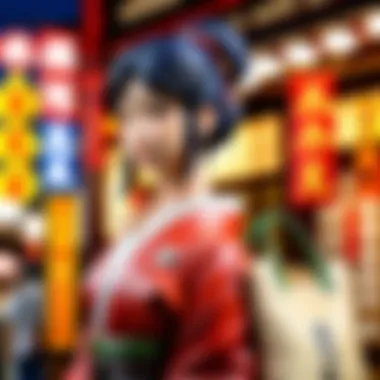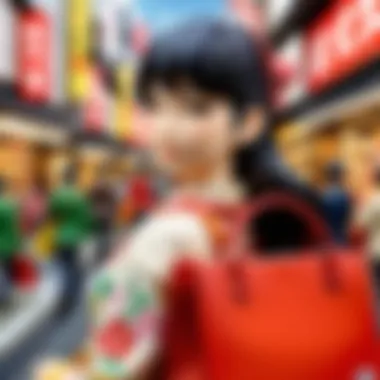The Cultural Importance of Lucky Bags in Japan


Intro
In Japan, the concept of 'lucky bags,' known as fukubukuro, is a fascinating blend of tradition and modern consumer culture. Every New Year, retailers unveil these mystery bags, offering an assortment of goods at a fraction of their expected retail prices. This tradition dates back to at least the early 20th century and has since transformed into an eagerly anticipated event for many consumers.
The allure of fukubukuro lies in its unpredictability, merging the excitement of chance with the joy of shopping. With each lucky bag potentially containing unique items, buyers experience both thrill and a sense of adventure. The cultural significance of this practice extends beyond mere shopping; it reflects societal attitudes towards consumption, value, and community.
As we explore this rich cultural phenomenon, we aim to uncover its historical roots, economic implications, and contemporary significance among diverse demographics in Japan. This article will delve into the multifaceted nature of fukubukuro, examining how it connects to the vibrant landscape of Japanese pop culture merchandise, and what it reveals about consumer behavior.
Key Points to be Discussed:
- Historical origins of fukubukuro and how it has evolved.
- Economic effects on retail and consumer spending.
- Cultural reception and significance among various demographics.
- Insights into distribution channels and product curation.
- Psychological impacts on buyers and their purchase decisions.
Fukubukuro is more than just a shopping experience; it intertwines with various aspects of Japanese society. Understanding this tradition provides a deeper insight into the intersection of culture and commerce in contemporary Japan.
The Concept of Lucky Bags in Japanese Culture
The concept of lucky bags, known as fukubukuro, plays a significant role in Japanese culture, especially during New Year celebrations. These bags embody a blend of tradition and contemporary consumer behavior. When buyers purchase a fukubukuro, they engage in a unique experience of anticipation and surprise. The contents of these bags are typically shrouded in mystery, making the act of buying one thrilling.
Fukubukuro serve as a cultural bridge connecting generations. While younger consumers may be attracted by the allure of chance, older generations value the tradition itself. This dual significance enhances the appeal of lucky bags across demographics. As those who participate in this tradition may reflect on the past and its nostalgia, simultaneously embracing modern practices, it becomes clear that fukubukuro help to maintain cultural continuity.
Moreover, the commercial impact of lucky bags can be substantial. Retailers often use them as a marketing strategy to boost sales during the holiday season. This aspect highlights fukubukuro as an economic phenomenon, intertwining cultural customs with modern retail practices.
In summary, understanding the elements and benefits of the lucky bag concept is essential. It showcases not only a cherished tradition but also a lively interaction between consumers and the market. Through this lens, the following sections will explore the origins of fukubukuro, their cultural significance during various festivals, and how they continue to shape the landscape of Japanese consumer culture.
Origins of the Tradition
The tradition of fukubukuro dates back to the Edo period (1603-1868). Initially, these mysterious bags were a way for merchants to clear out excessive inventory after the New Year rush. The concept was simple yet effective; consumers would purchase a bag without knowing its contents, which typically contained a range of items at a value higher than the price paid. This practice catered to the element of surprise, greatly appealing to customers.
Over time, what began as a means for inventory clearance evolved into a cultural ritual. The Japanese believe that good fortune can be acquired through this practice. As a result, many retailers, from small shops to large department stores, adopted the custom, ensuring that fukubukuro became an integral part of New Year festivities. The tradition has broadened to include not only physical goods but also experiences and services, solidifying its place in the modern market.
Cultural Significance in Various Festivals
Fukubukuro hold a prominent place in various Japanese festivals, particularly the New Year celebration. As businesses prepare for the year's start, these bags symbolize hope and prosperity. During this time, consumers eagerly anticipate the release of fukubukuro, often queuing for hours to ensure a chance at securing one. The act of purchase can foster community spirit, with friends and families engaging in discussions and sharing experiences about the contents of their lucky bags.
In addition to New Year festivities, the concept of fukubukuro can also be observed during other events, such as Hanami and even specialized anime conventions. Retailers may offer fukubukuro filled with thematic products, appealing to specific interests and fandoms. This adaptability ensures that lucky bags stay relevant in changing cultural contexts, resonating with varying consumer interests.
Overall, the cultural significance of fukubukuro reflects deep-rooted values of luck, community, and anticipation. They highlight the intersection of tradition and modern consumer behavior, showcasing how such customs can evolve while remaining meaningful in their essence.
"Fukubukuro represents a unique fusion between history and modernity, revealing how the past informs present consumer behavior."
By examining these aspects, one can appreciate fukubukuro not just as mere promotional products but as carriers of cultural narratives.
Understanding Fukubukuro
The concept of Fukubukuro holds significant relevance in analyzing the fabric of Japanese culture and its modern consumer habits. Understanding Fukubukuro allows one to appreciate both a traditional practice and a contemporary phenomenon that intersects with economy, culture, and consumer psychology. This exploration reveals how these lucky bags not only serve as marketing tools but also embody hope and a sense of community during sales seasons.
Definition and Common Practices
Fukubukuro, often translated as "lucky bag," refers to a special retail promotion wherein customers purchase bags that contain an assortment of mystery items. While the contents remain largely unknown, they are typically curated by retailers, creating an element of surprise.


Traditionally, Fukubukuro is made available during the New Year, with shops opening early to lure eager customers. However, the practice has expanded beyond this seasonal event to include various festivals and occasions throughout the year. Buyers often find themselves lining up hours before stores open, showcasing the excitement and eagerness associated with these bags.
Items usually found in these lucky bags range from clothing to accessories, gadgets, and even food. The contents are intended to exceed the bag’s purchase price, thus offering perceived value to consumers. This element of chance contributes to the bags' allure, compelling people to participate despite the uncertainty of what they might receive.
Legal and Economic Aspects
The legal framework surrounding Fukubukuro is deeply rooted in consumer protection laws within Japan. Retailers must, at minimum, follow existing regulations regarding product return and quality. However, since the contents are often randomized and sold at a discount, specific legal protections do not always apply. Customers frequently embrace the risk, viewing their purchase as a gamble rather than a traditional transaction.
Economically, Fukubukuro plays a pivotal role in driving sales. During the New Year season alone, retailers can witness considerable boosts in revenue. According to industry reports, stores can achieve annual goals in a matter of days through this lucky bag phenomenon.
Furthermore, the promotional nature of Fukubukuro helps retailers move seasonal inventory. Old stock can be bundled into these bags, allowing merchants to clear out slow-moving products while generating new customer interest. This strategy not only aids financial health for the retailer but also aligns effectively with consumer behavior, creating an eager market for mystery purchases.
"Fukubukuro is not merely a retail strategy; it is a cultural ritual that brings together consumers in anticipation and excitement."
In summary, understanding Fukubukuro is essential to appreciate its role in Japanese consumer culture. It encapsulates both tradition and modernity, influencing how people engage with retailers and ultimately shaping economic patterns. Its significance remains profound as it continues to adapt to evolving consumer preferences while maintaining a connection to its historical roots.
The Role of Retailers
Retailers play a crucial role in the fukubukuro phenomenon in Japan. Their influence extends beyond merely selling products; they shape consumer expectations, manage inventory, and drive marketing strategies, making them pivotal in the overall success of lucky bags. Retailers intricately curate the contents of these bags to balance appeal and cost-effectiveness, ensuring that customers perceive value in their investments. Furthermore, the excitement surrounding fukubukuro creates a sense of anticipation and loyalty among consumers, reinforcing the importance of the retailer's role in this cultural practice.
How Retailers Curate Lucky Bags
Retailers must carefully select items to include in each fukubukuro. The selection process involves analyzing market trends, consumer preferences, and product availability. Retailers often focus on popular items or seasonal products to maximize excitement and sales.
For example, during the New Year, many stores feature themed bags that might contain exclusive products or limited-edition merchandise. This not only encourages repeat business but also builds an image of exclusivity around the lucky bags. Retailers must also consider the potential for unsold inventory since poorly curated bags could lead to disappointment and frustration among consumers. Thus, they strive for a delicate balance of quality and variety.
Seasonal Versus Year-Round Offerings
The distinction between seasonal and year-round fukubukuro offerings is significant in retail strategy. Seasonal bags, often tied to specific holidays or events, generate buzz and excitement. They can reflect the spirit of a season, like New Year's or summer festivals, capturing cultural elements that resonate with consumers. Year-round offerings, on the other hand, provide more stability and predictability for retailers. These often include generic products that sustain consumer interest beyond specific events.
Understanding this difference helps retailers allocate resources efficiently, ensuring that seasonal promotions align with consumer demand while also maintaining consistent sales throughout the year. Retailers who master this duality can leverage both types of bags to enhance customer engagement and profitability.
Strategies for Maximizing Sales
Maximizing sales of fukubukuro hinges on several strategic approaches. Below are a few key strategies:
- Marketing Campaigns: Utilizing social media platforms and email marketing to generate buzz before the launch of lucky bags.
- Limited Quantities: Offering a limited number of bags encourages urgency and drives consumers to act quickly.
- Cross-Promotions: Collaborating with brands or influencers can attract a larger audience and enhance the perceived value of the bags.
- In-Store Events: Hosting events that celebrate the release of lucky bags can create a festive atmosphere, drawing customers in to experience the excitement firsthand.
The integration of these strategies not only boosts sales but also deepens the relationship between consumers and retailers, turning a simple transaction into a memorable shopping experience.
Consumer Behavior and Lucky Bags
The interaction between consumers and lucky bags, or fukubukuro, forms a critical aspect of their cultural significance in Japan. The act of purchasing a lucky bag combines elements of excitement, tradition, and economic strategy. It creates a unique buying experience that extends beyond mere transactions. Buyers anticipate unexpected surprises, and this element of surprise can significantly influence consumer decisions.
Understanding consumer behavior towards lucky bags involves examining the motivations behind purchases and the emotional responses they elicit. The allure of surprise taps into human psychology, creating a spectrum of reactions ranging from joy to anxiety. This dynamic makes lucky bags particularly appealing as they invite consumers into a realm where expectation and uncertainty coexist. Recent trends indicate that the excitement derived from these purchases often outweighs practical considerations, reflecting a deeper cultural phenomenon.
Psychological Appeal of Surprise
The psychological appeal of surprise plays a significant role in consumer behavior related to lucky bags. When individuals buy fukubukuro, they engage in an experience laden with anticipation and uncertainty. The expectation of discovering unexpected items creates a thrill that affects emotional gratification. This enjoyment often transcends a mere purchasing decision.
Moreover, consumers often share their finds on social media, fostering a sense of community and collective celebration. The added social value derived from sharing one's luck enhances the appeal of the lucky bag phenomenon. Retailers use this enthusiasm to boost recognition and sales. Thus, the psychological components of surprise drive not only individual purchases but also collective engagement within communities.


Demographic Trends Among Buyers
Demographic trends concerning buyers of lucky bags present a varied landscape influenced by various factors, including age, gender, and geographic location. Understanding these trends helps retailers tailor their products and marketing strategies effectively.
Age Groups
Age plays a crucial role in the appeal of fukubukuro. Younger generations, particularly those belonging to the millennials and Gen Z, demonstrate greater enthusiasm for these bags. This tendency can be attributed to their affinity for novelty and social media engagement. Younger buyers often seek unique and shareable experiences, making lucky bags an ideal fit for their shopping habits. While older generations appreciate the tradition, they may not exhibit the same impulsive behavior as younger consumers. Thus, this trend illustrates how age shapes attitudes towards lucky bags and serves as a target for marketing initiatives.
Gender Disparities
Gender disparities in lucky bag purchases reveal intriguing patterns. Research indicates that women are generally more inclined to purchase these bags compared to men. This inclination could stem from women’s greater interest in fashion and beauty items often featured in fukubukuro. However, men may engage with lucky bags focused on tech gadgets or pop culture merchandise. Retailers can leverage this insight into gender preferences to refine the thematic contents of their offerings, thereby maximizing appeal to different consumer bases.
Geographic Variations
Geographic variations also impact consumer behavior related to lucky bags. Urban areas, such as Tokyo, typically see higher demand for unique and trendy fukubukuro. These consumers heavily engage with pop culture, valuing limited-edition items. In contrast, rural consumers might prefer bags that emphasize practical, household, or traditional products. Understanding these variations enables retailers to design bags that resonate with local values and tastes, optimizing sales and customer satisfaction in diverse regions.
The ability to comprehend and adapt to consumer behavior is crucial in the dynamic landscape of fukubukuro sales. As trends evolve, so must the strategies behind these beloved cultural items.
Critical Perspectives on Lucky Bags
The topic of critical perspectives on lucky bags, or fukubukuro, is essential to this exploration. It provides an understanding of how this tradition is not only a cultural artifact but also a reflection of contemporary economic and social factors. Lucky bags represent more than just consumer excitement; they invoke discussions around satisfaction, economic consequences, and environmental sustainability.
Consumer Satisfaction Levels
The appeal of lucky bags often hinges on the element of surprise. Consumers expect to receive items of greater value than what they paid. However, satisfaction levels can vary widely. Some customers revel in the thrill of discovery, cherishing moments of unexpected delight. They often enjoy the novelty of the experience, which can elevate the joy of shopping itself.
On the other hand, many buyers express dissatisfaction when their bags contain items they do not want or need. This disparity creates discussions on the importance of transparency in what consumers can expect. Retailers are aware of these divides in satisfaction levels. They strive to curate collections that cater to their audience's desires while managing expectations regarding the possible outcomes of their purchases.
Economic Impact on the Industry
Lucky bags have a notable economic impact on retailers and the overall Japanese economy. For retailers, the initial sales boost during Fukubukuro season can significantly enhance their revenue. This surge is particularly evident immediately after New Year, when consumers are eager to embrace the tradition.
However, there are associated risks. Unsold inventory can lead to losses if products do not appeal once revealed. Additionally, retailers must balance between offering attractive products and the cost of those items. The success of lucky bags often reflects broader economic trends. In prosperous times, consumers may indulge more freely, while in downturns, preferences may lean towards more practical purchases.
Sustainability Concerns
The sustainability of producing and distributing lucky bags is another critical angle to consider. With discussions about waste and resource management gaining urgency globally, the practice of creating bags filled with potentially unwanted items raises significant concerns.
Retailers are increasingly scrutinized for their roles in these sustainability conversations. Questions arise about the environmental footprint of producing excess stock and the long-term impact of consumer habits linked to fukubukuro. Some brands have begun to take steps to address these issues, focusing on more thoughtful curation of contents and exploring ways to incorporate eco-friendly materials.
"In Japan, the cultural significance of fukubukuro goes beyond sales; it reflects consumer sentiment and response to broader societal changes."
In summary, critical perspectives on lucky bags encompass various elements that shape their ongoing relevance in Japan. By understanding consumer satisfaction levels, economic impacts, and sustainability concerns, one can appreciate the multifaceted role lucky bags play in modern Japanese culture.
Fukubukuro in the Context of Anime Merchandise
The integration of fukubukuro within the realm of anime merchandise highlights a compelling intersection between traditional Japanese culture and contemporary consumer behavior. This concept has rapidly gained traction due to the immense popularity of anime in Japan and around the world. These lucky bags are often filled with a mix of items that reflect current trends in the anime community, appealing to both casual fans and dedicated collectors.
Integration with Popular Culture
Fukubukuro has become a means for anime retailers to engage with a vibrant fanbase. Merchants often curate special bags containing limited-edition items, figurines, and other collectibles inspired by popular series. This approach not only provides fans with a sense of excitement but also cultivates a deeper bond with the content.


The cultural significance of these lucky bags extends beyond mere consumerism. They represent a unique blend of anticipation and surprise, essential elements of the anime experience. Each fukubukuro is like a mini treasure chest, and the surprise factor adds to the overall enjoyment of the product. In many respects, this echo the narratives often present in anime, where characters embark on unexpected journeys.
Special Collaborations and Features
Many retailers craft exclusive themes around their fukubukuro, often collaborating with well-known anime franchises. Some examples include My Hero Academia or Attack on Titan. These collaborations enhance the exclusivity and perceived value of the items inside. Often, retailers will highlight items that cannot be purchased separately; this unique aspect makes them particularly desirable.
Furthermore, many of these bags contain surprise items that serve as promotional material for upcoming anime series or films. For instance, a fukubukuro might include pre-release merchandise that provides a sneak peek into new shows, effectively generating buzz and excitement in the fan community.
In summary, the fukubukuro phenomenon within anime merchandise transcends mere sales tactics. It encapsulates how traditional cultural practices can adapt to modern pop culture, offering fans not just products, but experiences that resonate deeply with their passions.
Challenges Faced by Retailers
The concept of lucky bags, or fukubukuro, represents a unique intersection of culture and commerce in Japan. However, retailers engaged in this tradition encounter several significant challenges. Understanding these challenges provides valuable insights into the complexities of the retail environment surrounding lucky bags, informing both vendors and consumers. Addressing consumer expectations and managing logistics are crucial for a successful fukubukuro campaign.
Managing Consumer Expectations
One of the foremost challenges retailers face is managing consumer expectations. Unlike standard purchases, lucky bags are inherently unpredictable, as they contain an assortment of undisclosed items. Retailers must strike a delicate balance between offering appealing products and maintaining a level of surprise that meets customer satisfaction.
Expectations can vary significantly among different demographic groups. For instance, younger consumers might prioritize trendy items and branded products, while older generations may value traditional or nostalgic contents. It is vital for retailers to clearly communicate what consumers can expect, not only in terms of the themes of lucky bags but also regarding quality and value.
Effective communication strategies include:
- Detailed Previews: Offering glimpses of the types of items included can help set appropriate expectations.
- Transparent Pricing: Clearly stating the average value of items can reduce disappointment.
- Customer Feedback: Actively seeking and addressing feedback from past lucky bag purchasers can guide improvements.
This proactive engagement helps manage perceptions and fosters a sense of trust between consumers and retailers. If handled well, this can lead to repeat purchases and customer loyalty.
Inventory and Logistics Issues
Retailing lucky bags involves complexities in inventory management and logistics. The need to anticipate demand while managing stock effectively is particularly daunting. Retailers often prepare limited quantities of fukubukuro to create exclusivity, making it essential to accurately gauge consumer interest prior to sales.
Moreover, the rapid turnaround time for distribution adds another layer of complexity. Once the fukubukuro sales period begins, retailers must ensure they can fulfill orders quickly to avoid customer dissatisfaction. Delays can lead to heightened frustration among buyers, especially if they perceive that products are not reaching them timely.
Key logistics considerations include:
- Storage and Organization: Efficiently organizing inventory to ensure timely access during peak sales is critical.
- Supply Chain Coordination: Ensuring a reliable supply chain for procuring diverse items at bulk can reduce costs.
- Returns Management: Creating a policy for unboxed bags is important, as consumers may want to exchange or return items.
The Future of Lucky Bags in Japan
The future of lucky bags, or fukubukuro, in Japan is a topic of great relevance, particularly given the evolving landscape of consumer preferences and market dynamics. As this tradition continues to intertwine with modern retail practices, understanding its trajectory becomes essential for retailers and consumers alike. The intersection of cultural values and economic considerations will shape how lucky bags are perceived, produced, and purchased in the years to come.
Adapting to Changing Consumer Preferences
Consumer preferences are not static; they evolve based on various factors such as demographic shifts, economic conditions, and technological advancements. For retailers, encapsulating the essence of what makes fukubukuro appealing is crucial. This requires a keen understanding of the desires of contemporary consumers.
In recent years, younger generations in Japan, notably millennials and Gen Z, have begun to prioritize experiences over mere possessions. This shift highlights a necessity for lucky bags to adapt by incorporating experiences or exclusive events that can pique interest. For instance, collaborating with popular brands such as Sanrio or Studio Ghibli to create themed bags associated with experiences can enhance the value perceived by consumers.
Moreover, consumers are becoming more conscious of sustainability and ethical purchasing. Retailers must consider eco-friendly packaging and the sourcing of products within their lucky bags. Offering limited-edition, environmentally friendly items could not only meet contemporary desires but also bolster the appeal of lucky bags in a crowded marketplace.
Technological Innovations in Selling
The integration of technology into the sales processes of lucky bags is another facet that will shape their future. Retailers can now leverage digital platforms to create a more interactive and personalized shopping experience. For example, virtual reality experiences can allow consumers to explore the contents of a lucky bag before purchasing it, minimizing disappointment and fostering excitement.
Additionally, social media platforms such as Instagram and TikTok can be powerful tools for marketing lucky bags. By highlighting unique offerings and engaging with consumers through live unboxing events or polls, retailers can generate buzz and community around their products. Such engagement can significantly enhance brand loyalty and consumer interest, ensuring that the tradition of fukubukuro remains alive and appealing in an increasingly digital marketplace.
"The future of lucky bags is not solely about the contents, but the experiences and values they represent."
Ultimately, the path forward for lucky bags in Japan is not predetermined. It will depend on how effectively retailers can adapt to a fast-changing consumer landscape while remaining true to the cultural roots of fukubukuro. Embracing innovation while honoring tradition may be the key to sustaining this unique aspect of Japanese culture for future generations.



